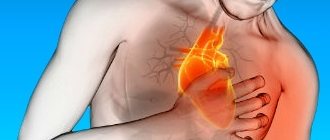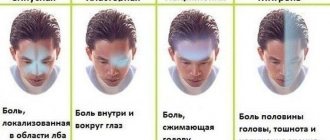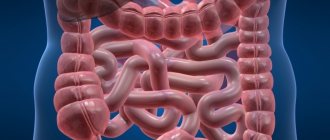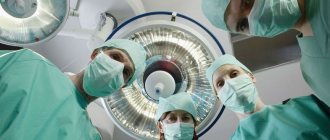It is not always common for a person to listen to the signals that his own body sends him - we simply ignore many of them, without even realizing that there may be something wrong in our body. However, the feeling of pain in the chest is difficult to ignore, and many people are immediately alarmed by it, because on the left side of the chest is the heart - a vital organ, on the correct functioning of which the functioning of all body systems depends. If you are bothered by any unpleasant sensations in the heart area, for example, sharp stabbing pains, tightness, or it seems to you that there is a “burning” in your chest, then this sensation definitely cannot be ignored, but it is worth asking yourself what the pain might be like. reasons for a burning sensation in the heart and what to do to improve your well-being.
When pain and discomfort occurs in the heart area, this symptom cannot be ignored
Causes of heart pain
Pain is a defensive reaction: this signal is the first to draw attention to changes in the functioning of organs.
A painful sensation in the heart area (cardialgia) may signal one of the dangerous diseases of the heart or blood vessels that participate in its blood supply. Sometimes pain that appears to be heart pain is actually caused by other illnesses. The reason for this phenomenon is the location of the structures of the peripheral nervous system, the irritation of which causes pain. Chest pain can be associated with the spine, intercostal nerves, esophagus and even the skin.
Cardialgia can be imitated by:
- Diseases of the musculoskeletal system: osteochondrosis of the thoracic spine, pain in the intercostal muscles.
- Pathologies of the nervous system: inflammation of the intercostal nerves, non-inflammatory intercostal neuralgia, panic attacks; vegetative-vascular dystonia, psychosomatics (pain that occurs due to psychological reasons without objective disturbances in the functioning of organs).
- Vascular pathologies: aortic aneurysm (thinning and dissection of the vessel wall), pulmonary embolism (PE) - blockage of a vessel with a blood clot.
- Diseases of the gastrointestinal tract: pathologies of the esophagus, gastritis, stomach ulcers, pancreatitis and other diseases of the pancreas, diseases of the gallbladder.
- Respiratory dysfunction: pneumonia (inflammation of the lungs), pleurisy (inflammation of the film of connective tissue that covers the lungs and chest from the inside), bronchial asthma, pneumothorax (penetration of air into the cavity where the lungs are located), tuberculosis and other pulmonary diseases.
- Pathological manifestations on the skin: herpes zoster (infection with the herpes virus in the form of a blistering rash).
Also, pain in the heart area can be a manifestation of the action of toxins - some narcotic substances and aggressive chemicals.
However, heart disease is suspected in every case of chest pain: first of all, it is necessary to exclude myocardial infarction, unstable angina, pulmonary embolism and other life-threatening heart diseases.
Risk factors for heart pain
First of all, it is important to assess the likelihood of cardiovascular disease: if it is high, any discomfort in the patient’s heart area may be a sign of acute pathology.
Risk factors for cardialgia can be divided into uncontrolled (which cannot be corrected) and controlled (lifestyle features, nutrition, medication, treatment of concomitant diseases).
Uncontrollable risk factors include:
- age over 55 years;
- male gender;
- genetic predisposition;
- racial characteristics.
Acquired risk factors most often arise due to non-compliance with the principles of a healthy lifestyle. Poor nutrition, lack of physical activity, smoking, emotional reactions to stress, alcohol abuse and other bad habits significantly increase the risk of cardiovascular disease.
Also controllable risk factors may be associated with concomitant diseases and borderline conditions. These include:
- overweight and obesity;
- high blood pressure;
- diabetes mellitus and prediabetes;
- imbalance of blood lipids.
On the other hand, there are positive factors that prevent the development of cardiovascular diseases (Fig. 1).
Figure 1. Factors that influence the development of cardiovascular diseases Source: MedPortal
Chest pain in children
Acquired heart pathologies in childhood are a rare situation. Pain in the heart area in children is most often associated with congenital conditions or diseases that are not related to the cardiovascular system:
- congenital heart defects;
- diseases of the gastrointestinal tract;
- neuralgia;
- inflammatory processes in the lungs;
- chest injuries.
Young children cannot indicate the specific point where the heart hurts or describe their sensations. Therefore, parents should be extremely careful to recognize alarming symptoms in time and consult a doctor.
Heart pain during pregnancy
Cardialgia during pregnancy is not always associated with cardiac disorders. Most often, discomfort in the chest of the expectant mother is associated with adaptation: the vessels of the unborn child are built into the woman’s circulatory system, and the heart needs to “rebuild” to perform its functions in new conditions.
Also, the cause of heart pain during pregnancy can be:
- anemia,
- toxicosis and gestosis - severe pregnancy,
- intercostal neuralgia,
- disturbances in the reactions of the nervous system,
- cardiomyopathy.
Heart pain can seriously frighten a pregnant woman. But don’t panic: in such a situation, it is important to remain calm and go to the hospital immediately.
Heart attack
Symptoms of a heart attack
The pain of a heart attack can also be described as a burning sensation in the heart. Typically, pain with a heart attack is more severe than with angina. It can reach such intensity that the patient begins to rush about in pain and may fall into an agitated state. Nitroglycerin tablets for a heart attack are ineffective, do not bring relief and do not eliminate pain.
What are the dangers of heart pain?
Pain in the heart area is a dangerous symptom that may indicate the development of a fatal disease. According to statistics, heart disease causes death in 30% of adults in all countries of the world.
If cardialgia is a manifestation of a heart attack, ignoring it can lead to irreversible consequences:
- necrosis - “death” of part of the heart muscle (infarction),
- development of arrhythmia - irregular heart rhythm,
- heart failure - inability of the heart to perform its function,
- sudden death.
In the event of a myocardial infarction, when a vessel leading to the heart is blocked, minutes count: blood flow must be restored within 1.5 hours. If you seek medical help late, changes in the affected area of the heart will be irreversible: the organ will no longer be able to work effectively (Fig. 2).
Figure 2. What is myocardial infarction Source: prostress.by
Herpes zoster
Symptoms of herpes zoster
This is a viral disease that is characterized by damage to the skin with rashes, as well as severe pain in the form of burning and itching. Even before the period of rash, itching, tingling, and a burning sensation occurs along the nerve trunks on the body, chest, and back. Symptoms of neuralgia precede the rash, and once the rash appears, diagnosis is simplified. As a rule, the lesion with herpes zoster is one-sided: rashes and burning occur along the intercostal spaces, nerves of the limbs, and neck on one side.
How to understand if pain is related to heart disease
The thought of heart disease is the first thing that comes to mind when pain appears in the chest. In this case, it is better to consult a doctor once again than to one day regret not taking your health seriously enough.
In order to promptly recognize cardialgia, it is important to know the localization of heart pain, their characteristics and features. A test will help determine the cause of the pain.
Where does your heart hurt?
The heart is located behind the sternum with a slight shift to the left. It is reliably protected by the chest and can change its location depending on the size and structure of the bone structures.
Cardialgia is usually not “point”: it is impossible to indicate a specific place where the pain is localized. In addition, the sensations often radiate—spread to other parts of the body.
The typical location of pain in the heart is directly behind the sternum or behind the chest on the left. In most heart diseases, including the most dangerous ones, heart pain moves:
- to the right side of the chest,
- under the left shoulder blade,
- in the axillary areas,
- in the shoulder and left arm, sometimes symmetrically on the right side,
- on the lower jaw and teeth,
- to the cervical spine,
- to the area under the sternum.
The area of pain in heart disease can be extensive (Fig. 3). Irradiation of cardialgia can cause difficulties in diagnosing heart diseases: symptoms in this case will indicate diseases of other organs.
Figure 3. Localization and irradiation of pain in the heart. Source: MedPortal
How does your heart hurt?
The characteristics of cardialgia depend on the disease that causes pain. First of all, a distinction is made between periodic and constant chest pain. This is important for determining the nature of possible changes in the heart.
Periodic pain
If pain in the heart is associated with a sharp narrowing of the vessels that fill the organ with blood, sharp but short-lived pain occurs - most often up to 30 minutes (Fig. 4). Taking heart medications helps the symptoms disappear quickly. A nitroglycerin tablet under the tongue is especially effective: the drug helps to immediately dilate the arteries and restore blood flow.
Figure 4. Short-term pain in the heart. Source: MedPortal
Constant pain
Prolonged acute pain in the heart most often signals dangerous disorders of the organ, for example, myocardial infarction. In this case, nitroglycerin does not help: poor circulation causes irreversible changes in the heart muscle.
Prolonged dull, aching, tingling pain may indicate chronic diseases of the cardiovascular system: heart defects, cardiomyopathies, inflammatory processes.
The nature of the pain
In the diagnosis of cardiovascular diseases, pain intensity plays an important role. For example, during an acute myocardial infarction, the sensations can be so intense that patients are given strong pain medications to prevent the development of shock.
Pain in the heart can be varied: sharp, burning, stabbing, pressing, aching, pulling, dull. Symptoms depend on the underlying disease, but the nature of the pain cannot accurately determine their cause: this requires certain research methods.
Also, pain syndrome is often complemented by other symptoms of diseases. For example, with acute pain in the heart, the rhythm often goes astray: there is a feeling of interruptions in its work, frequent or intermittent heartbeat.
Cardialgia can occur against a background of high blood pressure (BP). In these cases, signs of hypertension are added to the symptoms. Some heart diseases, on the contrary, are accompanied by hypotension - a decrease in blood pressure.
Myocardial infarction
When cardialgia manifests itself, it is first of all important to exclude acute myocardial infarction (MI) - the death of part of the heart muscle. Characteristic signs of MI:
- typical heart pain - behind the sternum, with reflection in the left arm, under the left shoulder blade, in the neck, lower jaw, ear;
- the nature of the pain is acute, burning, with extensive damage - unbearable;
- the severity of the sensations does not depend on the intake of nitroglycerin;
- the duration of pain is at least 30 minutes, with a large area of infarction it can last several hours or days;
- the pain is accompanied by a sharp deterioration in the condition, additional symptoms appear - dizziness, pallor, nausea, shortness of breath, sweating, rapid heartbeat, anxiety, fear of death.
It is important to know the first signs of myocardial infarction - this can help save a person’s life (Fig. 5).
If symptoms that are characteristic of a myocardial infarction develop, you must call 112 and seek emergency medical help. It is important to act quickly: you have only 1-2 hours to “save” the myocardium.
Figure 5. First signs of myocardial infarction Source: MedPortal
Heart pain in various heart diseases
If the diagnosis of myocardial infarction is excluded, it is necessary to look for another cause of heart pain.
Information about the location, nature and duration of sensations helps to establish a preliminary diagnosis (Table 1). Table 1. Features of pain in major heart diseases.
| Pathology | Description of pain |
| Angina pectoris (ischemia - narrowing of the coronary arteries) | Localization: behind the sternum with transition to the left shoulder blade, shoulder, jaw Character: strong, pressing, burning Duration: up to 20 minutes, after taking nitroglycerin it goes away within 2–3 minutes Features: most often the symptom occurs in the wake of emotional or physical stress, accompanied by a feeling of fear |
| Myocarditis - inflammation of the heart muscle | Localization: depends on the severity of the condition Character: dull, nagging, aching Duration: at the beginning of the disease the pain is short-lived, then it can become constant Features: does not go away after taking nitroglycerin |
| Heart valve diseases | Localization: depending on the location of the affected valve Character: depends on the pathology, most often aching, pressing Duration: can be long and even permanent Features: often accompanied by shortness of breath, aggravated by exposure to cold air, accompanied by irregular heartbeat, rapid heartbeat |
| Cardiomyopathies - changes in the size and function of the heart | Localization: depends on which parts of the heart are changed, can be localized or widespread Character: pulling, aching, squeezing Duration: may be constant or paroxysmal Features: often goes away after nitroglycerin tablets, but not always |
| PE - pulmonary embolism | Localization: left behind the sternum Character: depends on the level of arterial damage, more often - stabbing. Intense pain may be a sign of damage to the large branches of the pulmonary artery (this condition is life threatening) Duration: depends on the severity of the condition Features: shortness of breath develops, blood pressure decreases, pulse quickens, nitroglycerin does not work |
Important! Pain in the pericardial region is not always a sign of heart problems. But sometimes the heart hurts in a different way than usual. Some cardiac pathologies may manifest as pain in other organs, which significantly complicates the diagnostic search. For example, there are atypical forms of myocardial infarction:
- painless - does not show characteristic symptoms for a long time,
- abdominal - pain is localized in the abdominal area, simulating gastritis or pancreatitis,
- asthmatic - resembles an asthma attack,
- arrhythmic - the main symptom of the disease is not pain, but heart rhythm disturbances.
Heart pain and intercostal neuralgia
One of the common types of “non-cardiac” chest pain is intercostal neuralgia. The condition occurs due to damage to one of the nerves that are located between two ribs (Fig. 6).
Figure 6. Cause of pain with intercostal neuralgia. Source: c-clinica.com
The pain becomes so acute that it can be confused with a symptom of a heart attack.
But there are several features that make it possible to distinguish a neurological disease from a serious heart pathology (Table 2). Table 2. Differences between pain in heart disease and intercostal neuralgia
| Sign | Cardialgia | Intercostal neuralgia |
| Localization of pain | Pain sensations are concentrated behind the sternum, but the patient cannot indicate a specific place | The patient can accurately indicate the point of pain localization |
| Nature of pain | Burning, squeezing | Aching, shooting, pulling |
| Pain intensity | With angina pectoris, the pain lasts less than 15–20 minutes, with myocardial infarction - more than 30 minutes. The severity of pain depends on the severity of the lesion. With extensive myocardial infarction it is so intense that it becomes unbearable | The pain worries around the clock, its intensity does not depend on the time of day |
| Irradiation - spreading of pain | On the left side of the body - in the shoulder blade, shoulder, neck, arm | Between the ribs, along the intercostal nerves |
| Features of pain | Pain in the heart does not depend on movements, coughing, breathing | Pain increases when touching the intercostal spaces, when turning the body, walking, deep breathing, coughing |
| Taking nitroglycerin | Helps in most cases | Does not help |
| Connection with hypothermia | No | Often occurs in connection with neuritis - inflammation of the nerve due to hypothermia |
In addition, the following symptoms are characteristic of intercostal neuralgia:
- burning sensation on the skin at the site of the damaged nerve;
- impaired skin sensitivity, numbness, tingling in the chest area;
- muscle stiffness - difficulty moving on the side of the affected nerve.
However, it is impossible to exclude serious diseases only by assessing the pain syndrome: for this you need to do an electrocardiogram (ECG) and undergo other examinations.
Elimination of discomfort, first aid
Help measures are correlated with the severity of the manifestations and the root cause of the pathology. If chest discomfort is accompanied by prolonged pain, you must call an ambulance. Before her arrival:
- if angina is suspected, ensure rest, take a Nitroglycerin tablet;
- if the pain increases in intensity, the person should be placed on high pillows, the window should be opened, tight clothing should be loosened, and a second tablet of Nitroglycerin with Aspirin should be given, which must be chewed;
When there is pain in the heart or chest, the first aid algorithm at home should be differentiated:
- for intercostal neuralgia, take painkillers: Movalis, Ketanov, Nurofen, Ketorol;
- VSD can be stopped with sedatives: Novopassit, Persen, Afobazol, Deprim;
- diaphragmatic hernia with heartburn is treated with antacids: Rennie, Almagel, Phosphalugel;
- for hyperthyroidism, medications are used that reduce the activity of the thyroid gland;
- For menopause, hormone replacement therapy is used: Klimalanin, Divina, Klimen, Hormoplex, Premarin.
When should you see a doctor?
Seeking medical help is an important issue on which a person’s life may depend. It is better not to wait until the pain reaches its peak, but to immediately call an ambulance.
Even if pain does not initially seem like a serious symptom, it is better to be safe than sorry. However, some features of pain may indicate that acute myocardial infarction and other severe pathologies are unlikely.
Signs of a “relatively safe” variant of heart pain:
- the pain is stabbing in nature and lasts several seconds - most likely the cause of the symptom is overexertion or short-term dysfunction of the heart;
- it becomes easier during movements - in case of heart disease, pain intensifies with exertion;
- pain is associated with breathing - in acute heart diseases, shortness of breath may occur, but pain when inhaling, rather, indicates pathologies of the pulmonary system.
You should definitely not delay seeking medical help if:
- acute unbearable pain with a characteristic spread to the left shoulder blade lasting longer than 5 minutes;
- pressing pain in the heart for 30 minutes or longer;
- a sharp increase or decrease in pressure;
- shortness of breath or difficulty breathing;
- loss of consciousness;
- repeated episode of chest pain.
In any of these conditions, you must immediately call an ambulance - the wait can cost not only your health, but even your life.
Acute pain in the heart is an indication to immediately consult a doctor and get a cardiogram, even at a young age. And after 40 years, both women and men should be especially wary of myocardial infarction. In such situations, it is better to be safe than to waste time and not have time to save the heart.
Endocrine disorders
Pain is the body’s signal about a problem. There are many diseases of the endocrine system that are accompanied by chest pain. They are not limited to thyroid diseases.
Characteristic symptoms occur with pathology of the pancreas, adrenal glands, and pituitary gland.
The functioning of the entire body depends on the state of the endocrine system. Often the diseases are accompanied by increased heartbeat, fatigue and chest pain that resembles heart pain.
Treatment of heart pain
Pain is a symptom and therefore cannot be treated in itself. The method of therapy is selected only after determining the cause of pain.
Treatment begins with lifestyle changes: it is important to include all recommended ways to prevent heart disease in your list of daily activities.
Diet plays an important role: fried and fatty foods and sweets are excluded from the diet. The daily menu should contain a sufficient amount of fresh vegetables and fruits and fiber.
The patient is also offered to add physical activity to his daily routine - the duration and types of exercise are determined individually, depending on the identified disease.
Drugs for the treatment of heart disease are prescribed in a course or for long-term use. It is important to control blood pressure: for hypertension, medications must be taken daily, following the doctor's recommendations.
Therapeutic measures
To eliminate burning in the lower back, and not only, you should strictly adhere to the treatment regimen and follow all the doctor’s recommendations. Therapy includes medication and physiotherapeutic procedures. Experts believe that the best effect is observed from physical therapy.
Lumbar pain and burning in the interscapular region can be eliminated with the help of drug therapy, namely non-steroidal anti-inflammatory drugs and analgesics (Ketonal, Imet, Diclofenac sodium). The effect of physiotherapy will be more noticeable if you combine it with taking medications and therapeutic exercises.
Physiotherapy includes:
- electrophoresis with novocaine;
- ultrasonic influence;
- shock waves;
- magnetic influence;
- acupuncture.
You can add massage sessions, as well as diagnostics and procedures from a chiropractor. Preventive measures to suppress pain in the interscapular area include arm swings, especially for office workers, because they constantly sit. In most cases, it is a violation of blood microcirculation, with subsequent stagnation, that leads to a burning sensation in the back. From all of the above, we can conclude that burning in different parts of the back may be a symptom of a fairly serious disease. Therefore, you should not neglect this sign and immediately run to the doctor.
Prevention
Preventing a disease is always better than treating it. Therefore, even at a young age, you should think about the state of the cardiovascular system (Fig. 7). It is especially important for people at risk to follow all measures to prevent heart disease:
- to refuse from bad habits,
- control weight (body mass index should be less than 25),
- follow the principles of proper nutrition,
- avoid excess salt in dishes,
- exercise,
- avoid stressful situations and learn to react correctly to them,
- control blood pressure.
It is also important to promptly treat diseases of other organs. Hormonal diseases, inflammatory processes and other pathologies can cause heart complications.
Figure 7. Principles of prevention of cardiovascular diseases Source: MedPortal
Diseases of the esophagus
Due to the anatomical location of the esophagus from the sixth cervical to the eleventh thoracic vertebrae, diseases of the esophagus can manifest themselves in the form of pain, burning behind the sternum. Very often, with esophagitis, a burning sensation occurs in the chest, mainly after eating food, especially spicy, salty, smoked food. Other symptoms of burning may include: sore throat, heartburn, sensation of a lump in the throat, excessive salivation, belching. Other esophageal problems that have similar symptoms include reflux, achalasia, hiatal hernia, and esophageal diverticula.











